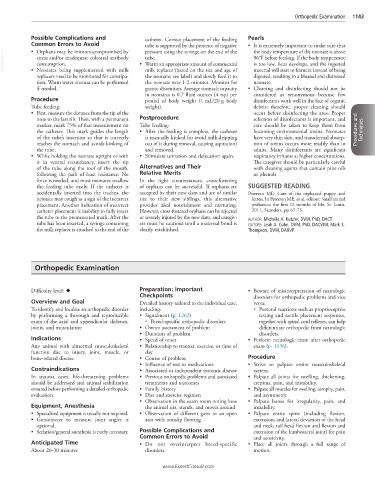Page 2300 - Cote clinical veterinary advisor dogs and cats 4th
P. 2300
Orthopedic Examination 1143
Possible Complications and catheter. Correct placement of the feeding Pearls
Common Errors to Avoid tube is supported by the presence of negative • It is extremely important to make sure that
VetBooks.ir stress and/or inadequate colostral antibody • Warm an appropriate amount of commercial 96°F before feeding. If the body temperature
pressure using the syringe on the end of the
the body temperature of the neonate is above
• Orphans may be immunocompromised by
tube.
consumption.
is too low, ileus develops, and the ingested
• Neonates being supplemented with milk
replacers need to be monitored for constipa- milk replacer (based on the size and age of material will start to ferment instead of being
the neonate; see label) and slowly feed it to
digested, resulting in a bloated and distressed
tion. Warm water enemas can be performed the neonate over 1-2 minutes. Monitor for neonate.
if needed. gastric distention. Average stomach capacity • Cleaning and disinfecting should not be
in neonates is 0.7 fluid ounces (4 tsp) per considered as synonymous because few
Procedure pound of body weight (1 mL/20 g body disinfectants work well in the face of organic
Tube feeding: weight). debris; therefore, proper cleaning should
• First, measure the distance from the tip of the occur before disinfecting the area. Proper
nose to the last rib. Then, with a permanent Postprocedure selection of disinfectants is important, and
marker, mark 75% of that measurement on Tube feeding: care should be taken to keep them from
the catheter. This mark guides the length • After the feeding is complete, the catheter becoming environmental toxins. Neonates Procedures and Techniques
of the tube’s insertion so that it correctly is manually kinked (to avoid milk dripping have very thin skin, and transdermal absorp-
reaches the stomach and avoids kinking of out of it during removal, causing aspiration) tion of toxins occurs more readily than in
the tube. and removed. adults. Many disinfectants are significant
• While holding the neonate upright or with • Stimulate urination and defecation again. respiratory irritants at higher concentrations.
it in ventral recumbancy, insert the tip The caregiver should be particularly careful
of the tube along the roof of the mouth, Alternatives and Their with cleaning agents that contain pine oils
following the path of least resistance. No Relative Merits or phenols.
force is needed, and most neonates swallow In the right circumstances, cross-fostering
the feeding tube easily. If the catheter is of orphans can be successful. If orphans are SUGGESTED READING
accidentally inserted into the trachea, the accepted by their new dam and are of similar Peterson ME: Care of the orphaned puppy and
neonate may cough as a sign of the incorrect size to their new siblings, this alternative kitten. In Peterson ME, et al, editors: Small animal
placement. Another indication of incorrect provides ideal nourishment and nurturing. pediatrics: the first 12 months of life, St. Louis,
catheter placement is inability to fully insert However, cross-fostered orphans can be rejected 2011, Saunders, pp 67-73.
the tube to the premeasured mark. After the or severely injured by the new dam, and caregiv- AUTHOR: Michelle A. Kutzler, DVM, PhD, DACT
tube has been inserted, a syringe containing ers must be cautious until a maternal bond is EDITORS: Leah A. Cohn, DVM, PhD, DACVIM; Mark S.
the milk replacer is attached to the end of the clearly established. Thompson, DVM, DABVP
Orthopedic Examination
Preparation: Important
Difficulty level: ♦ • Beware of misinterpretation of neurologic
Checkpoints disorders for orthopedic problems and vice
Overview and Goal Detailed history tailored to the individual case, versa:
To identify and localize an orthopedic disorder including: ○ Postural reactions such as proprioceptive
by performing a thorough and reproducible • Signalment (p. 1262) testing and tactile placement responses,
exam of the axial and appendicular skeleton, ○ Breed-specific orthopedic disorders together with spinal cord reflexes, can help
joints, and musculature • Owner assessment of problem differentiate orthopedic from neurologic
• Duration of problem disorders.
Indications • Speed of onset • Perform neurologic exam after orthopedic
Any animal with abnormal musculoskeletal • Relationship to trauma, exercise, or time of exam (p. 1136).
function due to injury, joint, muscle, or day
bone-related disease • Course of problem Procedure
• Influence of rest or medications • Strive to palpate entire musculoskeletal
Contraindications • Associated or independent systemic disease system.
In trauma cases, life-threatening problems • Previous orthopedic problems and associated • Palpate all joints for swelling, thickening,
should be addressed and animal stabilization treatments and outcomes crepitus, pain, and instability.
ensured before performing a detailed orthopedic • Family history • Palpate all muscles for swelling, atrophy, pain,
evaluation. • Diet and exercise regimen and asymmetry.
• Observation in the exam room noting how • Palpate bones for irregularity, pain, and
Equipment, Anesthesia the animal sits, stands, and moves around instability.
• Specialized equipment is usually not required. • Observation of different gaits in an open • Palpate entire spine (including flexion,
• Goniometer to measure joint angles is area with nonslip flooring extension, and lateral deviation of the head
optional. and neck; tail head flexion and flexion and
• Sedation/general anesthesia is rarely necessary. Possible Complications and extension of the lumbosacral joint) for pain
Common Errors to Avoid and sensitivity.
Anticipated Time • Do not overinterpret breed-specific • Place all joints through a full range of
About 20-30 minutes disorders. motion.
www.ExpertConsult.com

